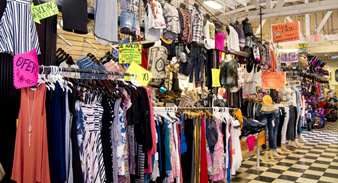Because 1979, El Faro Plaza has become Los Angeles's best indoor market, featuring over 250 suppliers, crafters, artists from all over the world, a real mix of Angelenos. This indoor swap meet, located in Los Angeles, is a one-stop shopping mall providing a wide variety of shops, food vendors, and home entertainment for the whole family. And all at a terrific cost! From foot massages to cars and truck window tinting, from underwear to quinceanera dresses, from unique birds to televisions, we have all of it under one giant roof.An indoor swap meet in the United States, particularly Southern California and Nevada, is a type of marketplace, a long-term, indoor shopping mall open during normal retail hours, with repaired booths or stores for the vendors.Indoor swap meets house suppliers that sell a wide variety of products and services, especially clothes and electronics. For instance, vendors in the Fantastic Indoor Flea Market in Las Vegas sell
clothes, furniture, handbags and toys, ... however there's a ton more: flowers and plants, family pet supplies, leather items, sporting equipment, fragrance and cosmetics, baggage and electronic devices, to name simply a few. There likewise are booths for services, including window tinting, palm reading, modifications, engraving and estate preparation. The majority of products sold here are brand-new, although antique alley does include some vintage and second-hand products. It is different in format to an outside swap meet, the equivalent of a flea market, generally open on a minimal number of days and typically without fixed areas for its vendors.

Indoor swap meets are present in lots of working-class neighborhoods throughout Southern California, with a concentration in Central Los Angeles. Indoor swap meets include the Anaheim Market, Fantastic Indoor Swap Meet in Las Vegas, and the High Desert Indoor Browse around this site Flea Market in Victorville. [5] Longstanding indoor swap meets that are now defunct include the Pico Rivera Indoor Flea Market [6] and San Ysidro Indoor Swap Meet.Swap meets in the U.S. long included U.S.-born vendors who sold primarily previously owned products in outside spaces. In the 1970s, Latino immigrants began selling cultural products and economical services at swap meets in Southern California and some swap meets begun resembling the tianguis, outdoor markets, of Mexico. At the same time, drive-in movie theaters were becoming less popular, and their owners excitedly rented them out throughout the day to outdoor swap meets, which multiplied. Then, mostly Korean immigrants utilized their connections in the growing import/export trade with Asia to set up their own swap meet stalls and equip them with brand-new, inexpensive items from Asia instead of secondhand items. In the 1980s and 1990s as residential or commercial properties South Los Angeles and parts of Central L.A. ended up being abandoned and hence, cheap, Korean immigrants purchased them and turned them into indoor swap meets.